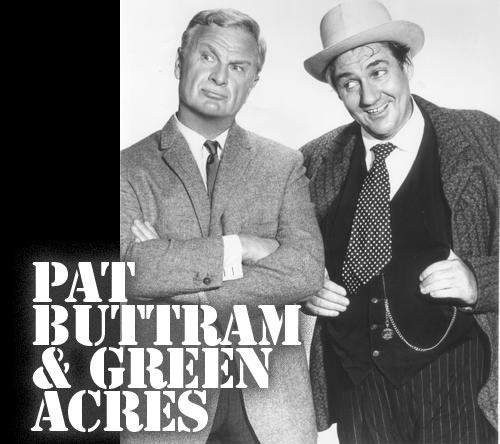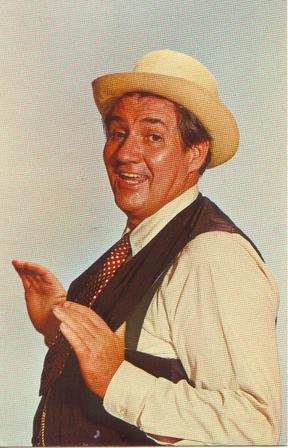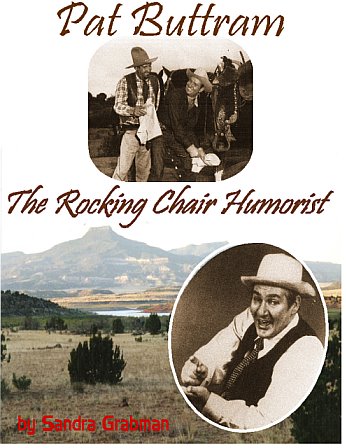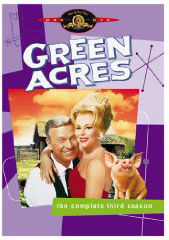
by Sandra Grabman
 They thought he would audition for the role of Eb, the hired hand. Pat found the part of Mr. Haney to be much more interesting, though. But, they pleaded, Mr. Haney is just a one-time deal. He’d just be in the first episode and nothing else. “We’ll see,” Pat said knowingly as he auditioned for Mr. Haney. Sure enough, the studio executives were charmed by his characterization of the lovable con man and gave him a permanent place in the series. They thought he would audition for the role of Eb, the hired hand. Pat found the part of Mr. Haney to be much more interesting, though. But, they pleaded, Mr. Haney is just a one-time deal. He’d just be in the first episode and nothing else. “We’ll see,” Pat said knowingly as he auditioned for Mr. Haney. Sure enough, the studio executives were charmed by his characterization of the lovable con man and gave him a permanent place in the series.
Green Acres began filming in the summer of 1965, in preparation for its fall debut on CBS. This thirty-minute situation comedy would be aired on Wednesdays at 9:00 p.m. Pat’s co-stars in this charming show were Eddie Albert, Eva Gabor, Tom Lester, Alvy Moore, Mary Grace Canfield, Sid Melton, Frank Cady, and Hank Patterson. Some of the regulars from Petticoat Junction would sometimes show up, as well, since the two rural shows were both set in Hooterville. Creator/writer Jay Sommers and executive producer Paul Henning were the heart and soul behind this mega-hit.
Coincidentally, Pat was now working occasionally with Smiley Burnette, who had been Gene Autry’s first sidekick. Smiley had the recurring role of Hooterville railroader Charlie Pratt in this series.
[Pat’s daughter] Kerry gives us the inside scoop: “Green Acres was a fun set. There were no prima donnas, no egos; just a well-coordinated group of professionals who knew how to write, direct and perform comedy. Dad fitted well into the way Jay Sommers and Dick Chevillat wrote. You see cornpone and expect that to be reflected in the dialogue, but what you get is a surprisingly sophisticated level of interaction. To be sure, there are running sight gags, such as Lisa’s rubbery pancakes and the closet door that continually falls off its rails, but the dialogues between Eddie Albert and Alvy Moore or Eddie and Dad, achieved all of the intricacy and precision of any Marx Brothers or Abbott and Costello routine.”
“Green Acres,” Kerry continues, “was inhabited by characters and subsets of characters who had their own peculiar logic. Writers Chevillat and Sommers stuck with that logic and kept the comedy character-driven, rather than situation-driven. The situation, city fish in country pond, was established at the outset. From then on, the characters drove the show. The viewer would expect Oliver, who is so keen on becoming a farmer, to be the one who adapts most easily. However, it is Lisa in her designer dresses, who fits right in, accepting without effort the circuitous logic of the Hooterville denizens, establishing an easy rapport with one and all, even unto cows, chickens and pigs.
“It is Oliver who is flummoxed by life and farming in Hooterville. His careful study of scientific farming journals comes to naught in a community where Doris’ lumbago determines which crops Fred Ziffel will plant.
“As Mr. Haney, my dad’s part in all of this was to anticipate what Mr. Douglas would need or want next and have it on his truck by 6:00 a.m. Dad said he modeled his Mr. Haney character partly on Colonel Tom Parker, Elvis Presley’s manager. Dad knew Elvis and the Colonel well, having made two pictures with Elvis and working often in Las Vegas.”
“The Green Acres years were happy ones for Dad,” says Kerry. “It was steady, home-for-dinner-every-night work and the show rated consistently in the Neilsen top ten.”
“Eva Gabor was a doll, a sweetheart and a thoroughly professional actress,” continues Kerry. “She was the same age as my mother [actress Sheila Ryan] and they started out at Fox together in the same ‘class’ of ingénues, studying under Max Reinhardt. I remember Mom told me Eva and Reinhardt worked like the devil to get rid of her Hungarian accent. It took a full six months and then it turned out she couldn’t get a job without the accent, so she ‘reacquired’ it.”
|


This article is an excerpt from this
book - buy it now!

|












